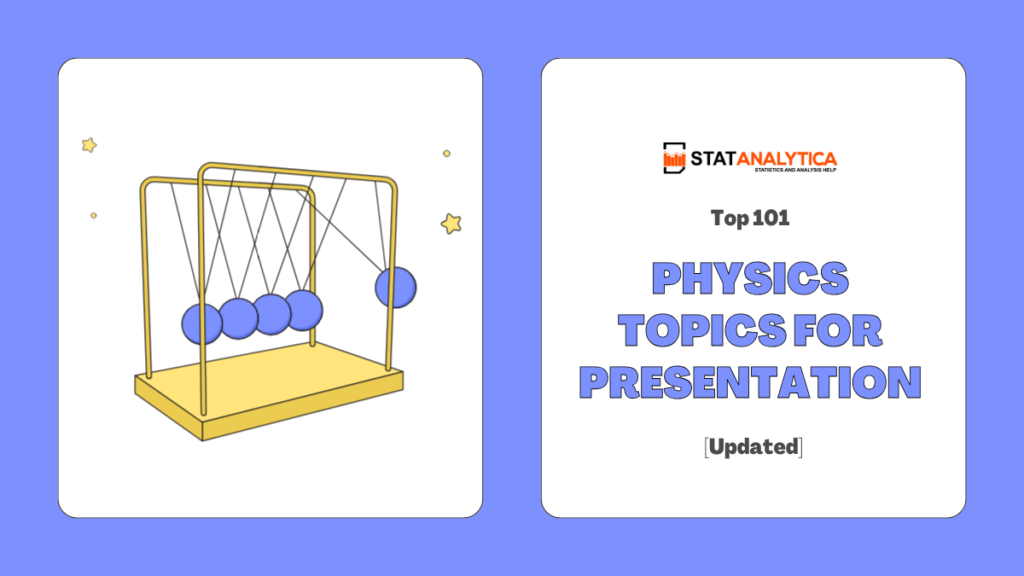Physics, the science that seeks to understand the fundamental principles governing the universe, offers a vast array of intriguing topics suitable for presentations. From classical mechanics to quantum physics, the realm of physics encompasses a wide range of phenomena that shape our understanding of the natural world. In this blog, we’ll delve into various physics topics for presentations, exploring their significance, applications, and relevance in everyday life.

How to Make Your Physics Presentation?
Table of Contents
Creating a compelling physics presentation involves careful planning, research, and effective communication of complex concepts in a clear and engaging manner. Here are some steps to help you make your physics presentation:
- Choose a Topic: Select a physics topic that interests you and aligns with your audience’s level of understanding. Consider the relevance and significance of the topic and its potential to engage and educate your audience.
- Conduct Research: Research thoroughly using trusted sources like textbooks, scientific journals, and reputable websites to grasp the topic’s key concepts.
- Develop an Outline: Organize your presentation into logical sections or themes. Use the outline provided earlier as a template, adapting it to suit your chosen topic and presentation format.
- Create Visual Aids: Prepare visual aids such as slides, diagrams, and animations to complement your presentation. Use clear and concise graphics to illustrate complex concepts and enhance audience comprehension.
- Craft a Clear Narrative: Structure your presentation with a clear beginning, middle, and end. Start with an attention-grabbing introduction to introduce the topic and establish its relevance. Present the main content in a logical sequence, highlighting key points and supporting evidence. Conclude with a summary of key takeaways and implications.
- Practice Delivery: Rehearse your presentation multiple times to familiarize yourself with the content and refine your delivery. Pay attention to pacing, clarity, and nonverbal communication cues such as posture and gestures.
- Engage Your Audience: Encourage active participation and interaction by asking questions, soliciting feedback, and incorporating interactive elements such as demonstrations or group activities. Tailor your presentation to the interests and background knowledge of your audience to keep them engaged and attentive.
- Anticipate Questions: Prepare for potential questions from your audience by anticipating areas of confusion or ambiguity in your presentation. Be ready to provide clarifications, examples, or references to further resources to address any inquiries.
- Seek Feedback: Solicit feedback from peers, mentors, or colleagues to gain valuable insights into areas for improvement. Consider their suggestions and incorporate constructive criticism to enhance the effectiveness of your presentation.
- Reflect and Iterate: After delivering your presentation, take time to reflect on your performance and the audience’s response. Identify strengths and weaknesses, and consider how you can refine your approach for future presentations.
By following these steps and applying careful planning and preparation, you can create a compelling physics presentation that effectively communicates complex concepts and engages your audience in the wonders of the natural world.
Also Read:- Computer Presentation Topics
Top 101 Physics Topics For Presentation
- Newton’s Laws of Motion
- Conservation of Energy
- Conservation of Momentum
- Projectile Motion
- Friction: Types and Effects
- Laws of Thermodynamics
- Heat Transfer Mechanisms
- Applications of Thermodynamics
- Electric Fields and Charges
- Magnetic Fields and Forces
- Electromagnetic Induction
- Applications of Electricity and Magnetism
- Reflection and Refraction of Light
- Wave Optics and Interference
- Optical Instruments: Microscopes and Telescopes
- Modern Optical Technologies
- Wave-Particle Duality
- Heisenberg’s Uncertainty Principle
- Quantum Tunneling
- Applications of Quantum Mechanics
- Special Theory of Relativity
- General Theory of Relativity
- Time Dilation and Length Contraction
- Black Holes: Formation and Properties
- Dark Matter and Dark Energy
- Atomic Structure and Spectroscopy
- Radioactivity and Nuclear Reactions
- Nuclear Energy: Pros and Cons
- Nuclear Medicine: Applications and Techniques
- Stars: Formation and Evolution
- Stellar Structure and Dynamics
- Galaxies: Types and Properties
- Cosmology: The Big Bang Theory
- Gravitational Waves: Detection and Significance
- Quantum Gravity: Theoretical Concepts
- String Theory: Basics and Implications
- High Energy Physics: Particle Accelerators
- Standard Model of Particle Physics
- Quantum Field Theory
- Symmetry in Physics
- Chaos Theory: Deterministic Chaos
- Fluid Dynamics: Flow Patterns and Applications
- Aerodynamics: Principles and Applications
- Bernoulli’s Principle
- Newtonian and Non-Newtonian Fluids
- Quantum Computing: Principles and Applications
- Cryptography: Quantum Key Distribution
- Quantum Teleportation
- Quantum Entanglement
- Bose-Einstein Condensate
- Superconductivity: Phenomena and Applications
- Magnetic Levitation: Maglev Trains
- Quantum Dots: Properties and Uses
- Nanotechnology: Applications in Physics
- Carbon Nanotubes: Structure and Properties
- Graphene: Properties and Potential Applications
- Optoelectronics: Devices and Technologies
- Photonics: Light-based Technologies
- Lasers: Principles and Applications
- Holography: 3D Imaging Techniques
- Quantum Sensors: Principles and Applications
- Quantum Metrology: Precision Measurements
- Quantum Biology: Biological Processes from a Quantum Perspective
- Quantum Optics: Manipulation of Light at the Quantum Level
- Quantum Materials: Properties and Potential Applications
- Quantum Algorithms: Computational Advantages of Quantum Computing
- Topological Insulators: Unique Electronic Properties
- Neutrinos: Properties and Detection
- Neutron Stars and Pulsars
- Magnetars: Extremely Magnetic Neutron Stars
- Cosmic Rays: Origins and Effects
- Solar Physics: Sunspots and Solar Flares
- Aurora Borealis and Aurora Australis
- Space Weather: Impact on Earth and Satellites
- Plasma Physics: Properties and Applications
- Fusion Energy: Achievements and Challenges
- Particle Astrophysics: Cosmic Rays and High-Energy Particles
- Quantum Astrophysics: Applying Quantum Mechanics to Cosmological Phenomena
- Exoplanets: Discoveries and Characterization
- Astrobiology: Search for Extraterrestrial Life
- Cosmic Microwave Background Radiation
- Black Hole Thermodynamics
- Gravitational Lensing: Observational Effects
- Multiverse Theory: Theoretical Implications of Cosmology
- Quantum Consciousness: Theoretical Considerations
- Quantum Gravity: Unifying Quantum Mechanics and General Relativity
- Quantum Cosmology: Cosmological Models Based on Quantum Theory
- Quantum Field Theory: Foundations and Applications in Particle Physics
- Quantum Gravity: Approaches and Challenges
- Quantum Chromodynamics: Theory of Strong Interactions
- Quantum Electrodynamics: Theory of Electromagnetic Interactions
- Quantum Spin: Properties and Applications
- Quantum Hall Effect: Topological Phenomenon in Condensed Matter Physics
- Quantum Phase Transitions: Critical Phenomena in Quantum Systems
- Quantum Computing: Architectures and Algorithms
- Quantum Communication: Secure Communication Based on Quantum Principles
- Quantum Simulation: Modeling Complex Quantum Systems
- Quantum Cryptography
: Secure Communication Using Quantum Key Distribution - Quantum Sensing: Ultra-Precise Measurement Techniques
- Quantum Metrology: Achieving High Precision with Quantum Techniques
- Quantum Technologies: Emerging Applications of Quantum Physics
Tips to Fellow to Make Physics Presentation Successful
Making a physics presentation successful requires careful planning, effective communication, and engaging presentation skills. Here are some tips to help your fellow make their physics presentation successful:
- Know Your Audience: Understand the background knowledge and interests of your audience to tailor your presentation accordingly. Adjust the level of technical detail and terminology to ensure clarity and engagement.
- Define Clear Objectives: Clearly define the objectives of your presentation, outlining what you aim to achieve and the key points you intend to convey. This will help you stay focused and ensure that your presentation delivers a coherent message.
- Organize Your Content: Structure your presentation in a logical manner, with a clear introduction, main body, and conclusion. Use headings, subheadings, and bullet points to organize your content and guide the audience through your presentation.
- Use Visual Aids Wisely: Incorporate visual aids such as slides, diagrams, and animations to enhance understanding and retention of key concepts. Keep visual elements clear, concise, and relevant to the content of your presentation.
- Practice Delivery: Rehearse your presentation multiple times to familiarize yourself with the content and refine your delivery. Pay attention to pacing, tone of voice, and body language to ensure confident and engaging presentation delivery.
- Engage Your Audience: Encourage active participation and interaction by asking questions, soliciting feedback, and incorporating interactive elements such as demonstrations or group activities. Engage with your audience to maintain their interest and attention throughout your presentation.
- Clarify Complex Concepts: Break down complex concepts into simpler, more understandable terms, using analogies, examples, and real-world applications to illustrate key points. Clarify any technical jargon or terminology to ensure that all audience members can follow along.
- Be Prepared for Questions: Anticipate questions from your audience and prepare thoughtful responses in advance. Be open to feedback and willing to address any uncertainties or misconceptions that may arise during the Q&A session.
- Demonstrate Enthusiasm: Convey your passion and enthusiasm for the subject matter through your presentation delivery. Demonstrate genuine interest and excitement in sharing your knowledge with your audience, inspiring curiosity and engagement.
- Seek Feedback: After delivering your presentation, solicit feedback from your audience and peers to gain valuable insights into areas for improvement. Reflect on their input and incorporate constructive criticism to enhance the effectiveness of your future presentations.
Conclusion
Physics is fascinating! It’s like a colorful quilt filled with amazing ideas and things that make us wonder about the universe. Whether we’re talking about basic stuff like how things move or super cool things like quantum mechanics, physics presentations help us understand how the world works. They show us the important rules that make everything tick, from tiny atoms to huge galaxies.
By learning about physics, we can see how clever humans are in figuring out nature’s secrets and using them to make awesome technology. It’s like unlocking a treasure chest full of wonders and surprises!
This blog was all about providing valuable insights on the topic! At Statanalytica, we go beyond just information—we offer live tutoring and consultation in data science, data analytics, accounts, and statistics. Get instant help from the best experts and excel in all your academic challenges. Click here to explore the best Physics Assignment Help.


